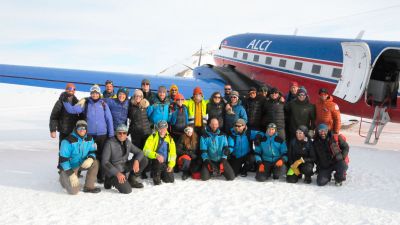
New Scientists Arrive with Final Team Rotation of Season
It’s been a busy time at the Princess Elisabeth. Scientists from the Mass2Ant, CLIMB, and PEACE projects along with the station cook for mid-season and a few members of the station’s technical team left the Princess Elisabeth Antarctica on Friday, January 14. The 15 people who left were replaced by six new people, including scientists, station engineers, and the final cook for the 2021-22 season.
Arriving via Novo Station, the six new arrivals quickly settled in, did their field training, and got started on their respective research projects or duties.
In addition to engineer Johnny Gaelens making a return to the station after three years of absence and a new cook, Thomas Fontaine, the station welcomed four new scientists who will spend the next few weeks conducting research on diverse topics.
Return of the GIANT
Two of the scientists who arrived on January 14 included Olivier Francis and Sajad Tabibi from the University of Luxemburg. They’re here working on one of the oldest ongoing research projects at PEA - the GIANT project, which, as those of you who have followed the Princess Elisabeth Antarctica for years may remember is using geodesic techniques (including gravimetric and gnosis observations) to track the mass balance of the Antarctic Ice Sheet in the region of the Princess Elisabeth Antarctica.
These measurements will contribute to a greater understanding of how quickly the Antarctic Ise Sheet is gaining or losing mass. Combined with measurements taken in other parts of the white continent, determine where the ice sheet is gaining mass and where it’s losing mass. As 90% of the world’s freshwater is contained in the Antarctic Ice Sheet, how rapidly the ice sheet loses mass to the oceans can determine how much sea level rise will occur in the coming years as the climate changes.
The work the GIANT team is doing perfectly complements the work of research projects such as Mass2Ant.
This season, the GIANT researchers plan to update their equipment. They’re upgrading the GNSS (Global Navigation Satellite Systems) antenna at PEA, and installing a GNSS antenna at the nearby abandoned Japanese Asuka Station, 60 km north from PEA. They also plan to repeat absolute gravity measurements the project has been taking intermittently over the last decade to see if snow accumulation on the ice sheet in the region is permanent or not.
A unique Horizon 2020 project
Another new arrival is Quentin Van Hellemont from the Royal Belgian Institute of Natural Sciences. He’s spending a few weeks with us to take some measurements for the Horizon 2020 funded HYPERNETS project.
The EU-funded project has developed a new low-cost multi-head hyperspectral spectroradiometer that works as an in-situ validation for satellite measurements of surface reflectance of solar radiation on both land and water. The project is measuring visible, near-infrared, and shortwave infrared radiation reflected from the snow and ice in the vicinity of the station.
The project chose 24 places around the planet to take these validation measurements, including in the vicinity of the Princess Elisabeth Antarctica.
The amount of radiation reflected from various surfaces on Earth plays an important role in how much solar radiation is absorbed by the planet and how much is reflected back into space, and plays a key role in climate change. Lighter surfaces with snow and ice reflect more solar radiation, while darker surfaces free of snow and ice absorb more solar radiation, contributing to greater warming of the planet.
Macro-biology at PEA
While a number of microbiological studies have taken place at PEA over the years, this season marks the second season since the station’s inauguration that it has hosted biologists looking at macro fauna and the continuation of the BELSPO-funded RECTO project (initiated in 2017 with the census of Snow Petrel around the Western Sør Rondane Mountains). Bruno Danis, who heads the Marine Biology Lab at the Unviersité Libre de Bruxelles (ULB), arrived last week to start his research project to survey the land and marine biodiversity in the vicinity of PEA.
He’s doing some work alongside the ANTSIE project, studying the stomach contents of snow petrels to see if they’ve ingested pollutants such as PCBs or microplastics. Although Antarctica is a remote continent, its inhabitants aren’t immune from being affected by pollution from more inhabited parts of the world. Atmospheric and ocean currents bring this pollution to Antarctica, too.
Bruno will also spend a good part of his expedition at the coast with Expedition Leader Alain Hubert and Mechanic Tim Grosrenaud dropping a GoPro yo-yo cam from the edge of ice shelves to get snapshots and videos of the creatures living close to the ice edge of the Droning Maud Land coast. Baited traps will also be deployed to assess the scavenger biodiversity of the seabed. Marine scavengers are good bioindicators as they are numerous, easy to sample, and they play an important role in recycling the organic matter in the marine ecosystems of Antarctica.
Alain and Tim - who have already done a reconnaissance of the coast to determine the best study sites for the RECTO project and determine the next season’s transport ship landing site, will assist Bruno in his sampling by assembling and operating a 2000 metre-long winch equipped with a telescopic mast from which he’ll let the yo-yo cam drop into the briny deep away from the ice shelf to take photos of the sea floor and to detect living organisms.
By investigating the poorly known Droning Maud Land coast, Bruno hopes that information he collects on this trip will provide research material for future Masters and PhD students and help prepare future biological resarch expeditions to this part of Antarctica.
Picture: scientists doing stuff - © International Polar Foundation
